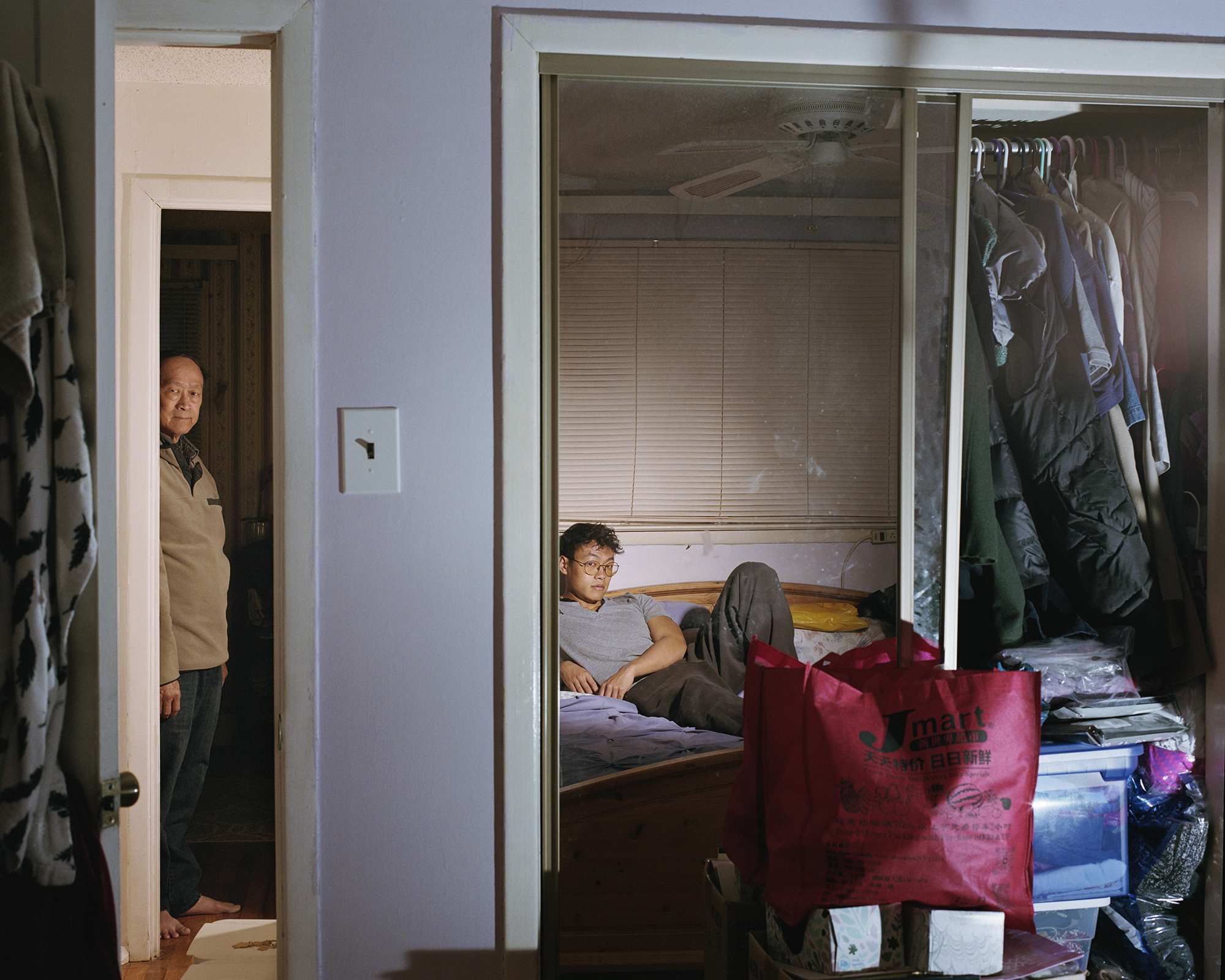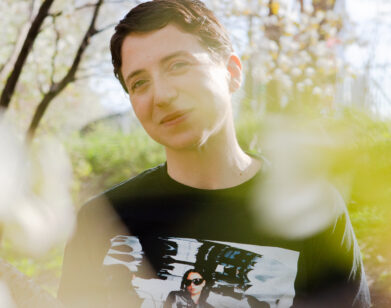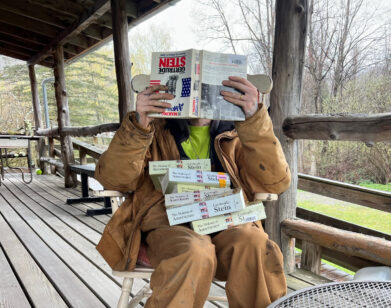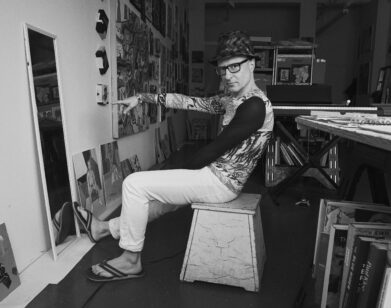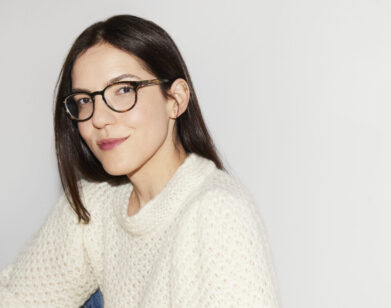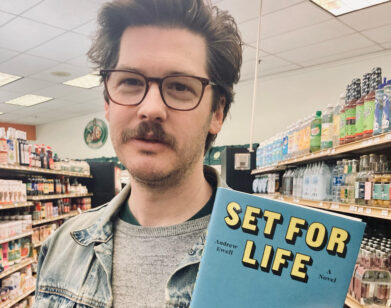LIT
Writer Simon Wu on Political Art, Rave Culture, and “Asian American-Core”
“I wondered if peeing in this man’s mouth would count as a practice of the theory of queer ecology,” writes Simon Wu in his new essay collection, Dancing On My Own. A curator and writer, Wu’s playful consideration explores everything from raving to art-world drama to Bushwick fashion, breathing life into the tired tropes that sometimes weigh heavy in what he calls “Asian American-core” writing. “Both the vaguely Asian and overtly Asian are aesthetics I find interesting and fun,” he told me when we sat down together a week ahead of his book release. “But they are also backed in different kinds of experiments in different economies. How the U.S. treats China can trickle down into how I feel walking down the street.” Hyper-aware of the skirt I was wearing, a mesh and silk midi printed with traditional Chinese emblems, we chatted about everything from the theory hidden in an Instagram influencer’s briefs exhibited in a Chinatown art show to the aesthetics of making stuffed animals with your mom.
———
LILY KWAK: I wanted to start off by talking about your references. Your book’s name is citing Robyn’s song, “Dancing On My Own,” and your first essay, A Model Childhood, cites Ken Okiishi’s exhibition of the same name. There’s a rich archive of cultural references you assemble into your personal essay and cultural criticism. I think you’ve talked about this elsewhere as a practice you’re beginning to experiment with.
SIMON WU: Yeah. It’s partly because I started out writing about art. I wasn’t a heavy creative writing person, and I don’t really write about myself ever. Many of the pieces [in my book] came out of writing about artworks or cultural works through the personal. Now, I think that the book has kind of cured me. For a long time, if I set out to write an essay about myself, I would have no words. There would be nothing. But the deeper I dig into someone else’s work, usually I end up having to look back on myself more.
KWAK: Yeah, they can channel your thinking in unexpected ways.
WU: Definitely. It’s like a prompt.
KWAK: You also talk a lot about scrambling signs and finding new ways of seeing cultural products that are densely constructed. There’s a part I loved when you were writing about CFGNY’s exhibition, which displayed DIY versions of high-fashion accessories, like a pair of briefs made in Vietnam with the label CALLVIM KERNEL, and they were allegedly worn by an Instagram influencer named Franky. You’re like, “We don’t know who Franky is, but how many people do these briefs put us in touch with?” The lens you view the world through has a sort of joy or buoyancy, which I found refreshing in a discourse that’s often so steeped in stereotypes.
WU: Aw, that’s so sweet. I wrote it because I want to talk about a lot of these questions. They were things that felt self-evident amongst me and my friends, but I had never seen them put on paper anywhere.
KWAK: Yeah, that’s so relatable. In your first essay, you return to the metaphor of the home, which a lot of Asian American writers find material in. You describe immigrant parents as “architects of mobility,” actively constructing new universes. Hoarding habits are likened to “drinking from the bountiful rain of capitalism when others seem to be ignoring it.” And at one point, you’re just like, “Capitalism is fun and convenient.” It’s really interesting.
WU: I think that’s true. Going into the first essay, I was thinking about the genre of Asian American personal essay where there’s almost a set of topics that people write about. But I think there’s a way to talk about it that’s not cliche or too Asian American-core.
KWAK: What is Asian American-core?
WU: I feel like it’s talking about your parents cutting fruit for you and—
KWAK: Oh, stinky food.
WU: Stinky food in the lunchbox. It’s a lot of guilt. There’s a lot of filial piety. It’s a lot of romanticizing, I think, of parents’ experiences. I don’t find myself exempt from pretty much most of those experiences, but I didn’t always feel that they were the most interesting things to write about. I was reframing parents as actual entrepreneurs who’ve found their own way to another country, and they’re not victims.
KWAK: Yeah. I have conversations with my Asian American friends about how sickening it can be sometimes to read writing that makes us continuously sit in a place of melancholia or alienation. Can you talk more about the utility of the home aesthetics for you?
WU: It was an aesthetic that always existed throughout my childhood, like little keychains or cute stickers on stuff. Now that Miu Miu is doing it, it’s a whole different thing, but growing up, I did crafts with my mom and I was never attuned to it or gave value to it. It was only going to school and becoming equipped with tools for looking at it. Meeting Dan and Tin at CFGNY cast my gaze at all the stuff happening at my parents’ house. I went back home and I was like, “Everything is beautiful in an interesting way.” And it was a challenge to treat that in a way where it’s not like, “Immigrant art is art too.” There’s something more interesting about it than that, and that was kind of the challenge.
KWAK: You make a point that we have all these choices in front of us, and that we don’t have to wait for the next life to build a universe. It was interesting to hear you then apply that, in the following essay, to a conversation about art.
WU: Yeah. I’ve met many different kinds of artists producing a lot of different kinds of work. Some are really invested in the particularities of paint or just video, whereas others are deeply socially engaged. I think that in a lot of ways, artists who are more politically engaged make space for the artists who don’t want to or don’t need to be. Not all art needs to be invested in social change and not all art is completely unattached.
KWAK: Right. And your thinking process is guided by the legacy of two Asian American collectives, Godzilla and the Asian American Arts Center. You said something like, “You don’t need to relegate yourself to a two-room hotel, roam the meadows outside.” And maybe that’s what the metaphor of dancing on your own is about, too.
WU: Yeah, that’s definitely one of the premises. Godzilla is an interesting case study because you can see their inception and then trace their careers 20 or 30 years later. It’s hard to say whether being separatist or integrationist is best. In my experience, it’s not always about trying to offer solutions. It’s about being able to see the problem.
KWAK: I was also really interested to hear you write about the designer Telfar Clemens, who was born Steven Clemens, and the Cuban American artist Félix González Torres who strategically removed the accent from his name. And you say something along the lines of, “We need both Steven and Telfar, and Felix and Félix” to exist.
WU: Telfar and Felix, they continue to be interesting, difficult examples of this utopian idea of being poor. It’s too simplistic and discrediting to talk about a project like Telfar like, “Well, they became really capitalist, so it doesn’t work.” It doesn’t capture the kind of culture they traffic. But I do think that these questions arise for a young person navigating our world as any cultural producer, when you have to think about how you’re going to monetize your production or your identity or your race. There are times where you use it to your advantage and then it doesn’t feel very good. You’re like, “Oh, actually, I don’t like how that felt.” I think back to the days when I was with my friends, Rosa and Alberto, and we’d sneak into parties. That’s kind of how it felt just going through that door.
KWAK: And you relate that back to Telfar’s branding of, “Not for you, for everyone.” I’m just curious, what other historical Asian American collectives are you researching besides those mentioned in your book?
WU: There are some other collectives out there that are really interesting. The Bernadette Corporation. Emily’s Sassy Lime, an all-girl punk band from the West Coast that were around in the ’90s and would sneak out of their parents’ garages in middle school and do punk shows.
KWAK: Cool. You also have a whole section about the “vaguely Asian” versus the “overtly Asian.” I think I subconsciously put together a vaguely Asian outfit today.
WU: [Laughs] Yeah, the slippers, maybe. I feel it.
KWAK: Can you explain what you mean by these aesthetics?
SIMON WU: Totally. “Vaguely Asian” is this term that the art collective CFGNY coined, and when I first encountered it, it felt so right for how I sometimes feel about my identity. It’s a certain aesthetic where you just see it and if you know, you know. On the surface, there are certain signs that are shared by anyone of the Asian diaspora, but what’s interesting about it is that it’s also about querying an economic system. CGFNY works with these tailors in Vietnam who are not necessarily the kind of prototypical factory worker that you mythologize in your head. It is a different production system than something like Telfar, maybe, where you order something and then you make it here.
KWAK: Right.
WU: And the “overtly Asian” is the most stereotypical role of signs and symbols, and probably is recognizable to even those who are not in the Asian diaspora. It’s also very dependent on geopolitics. The US-China relationship is always shifting, and sometimes people are thinking that China is this aggressor, but other times they’re really into it, and now it’s this aesthetic. How the US treats China can trickle down into how I feel walking down the street.
KWAK: Right. It was interesting to see your list of vaguely Asian items.
SIMON WU: Oh, yeah. I’d have to fact check this, but apparently Marco Polo went to China and then saw noodles there and brought it back to Italy, and pasta in Italy is actually based on noodles in China.
LILY KWAK: Interesting. Another thing you talked about was raving, specifically as an opportunity for ego death and self-annihilation. What do you find absorbing about raves created for an Asian American community?
WU: It’s not something I grew up with at all, and then I kind of came at it through music. It’s also just a very large, faceted contemporary Asian American experience that I hadn’t seen written about at length. So a lot of it is from personal experience of living in New York. And my friend Julie [Chen, a poet and musician] is from the West Coast. She has lived in San Jose, and for her, these raves were kind of a thing growing up. So we would go to these parties and it would almost feel like anthropological research. Like, there’s Asian people here, how did you get here? And the festival rave family culture is different from queer rave culture. I never felt quite at home at either, really. Even at queer raves, I never felt like, “This is my home.” It was always like, “Oh, the music is fun. I like dancing.” I think it partly comes from not quite being an insider.
KWAK: And another part I really enjoyed was when you were bridging theory with more material practices. There’s a lot of people writing about queer ecology right now, and there’s a moment where you talk about being at a club in Berlin where there’s a dude hunched next to your urinal, and you’re like, “Is peeing in this man’s mouth a practice of queer ecology?” which I found really funny.
WU: Yeah. I like to read a lot of theory, and there was a time where I was like, “When I read theory, I want to test it in real life immediately.” It’s like, I’m looking for how to live my life. How can I live my life and do less harm and feel good and help my friends? I read theory to encounter very strong ideas about that.
KWAK: Yeah. It’s like, “I’m not reading self-help books, I’m reading theory to guide my life.” Did you know that at one point, instead of therapy, you could get philosophers for hire to advise you with your life?
WU: Whoa. That’s very interesting. I would be curious.
KWAK: I want to throw a Warhol question at you. Where do you dance these days?
WU: I love Warhol. [Laughs] I feel like when I’m looking for just pure pop music, no frills, I go to The Rosemont. It’s easy and there’s a backyard. I went to the recently reopened Rash and it’s really fun. If I’m trying to die, I’ll go to Merge or something, but I haven’t been in a really long time.
KWAK: Who are you listening to these days?
WU: I’ve been listening to Chappell Roan, like everyone.
KWAK: Yes.
WU: And Lana. I’m getting more into Yeule.
KWAK: Oh, I don’t know them. Singaporean?
WU: Yeah. They are kind of like digital Olivia Rodrigo. And then Charli XCX.
KWAK: Do you have a favorite song on Brat?
WU: I love “Apple.” I also like the one about Sophie, and then the one about having a baby.

